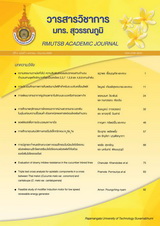การศึกษาพฤติกรรมการไหลของอากาศผ่านแถวทรงกระบอกตันในอุโมงค์ลม ความเร็วลมต่ำ ด้วยเทคนิคพลศาสตร์ของไหลเชิงคำนวณ
Main Article Content
Abstract
ในการวิจัยนี้ได้การศึกษาและวิเคราะห์รูปแบบพฤติกรรมของอากาศผ่านแถวทรงกระบอกตันด้วยเทคนิคพลศาสตร์ของไหลเชิงคำนวณ (CFD) และเปรียบเทียบผลการทดลองกับการทดลองจริงในอุโมงค์ลมความเร็วลมต่ำของระบบทำความเย็นแบบระเหยตามแบบมาตรฐาน ANSI/ASHRAE 41.2-1987 standard methods for laboratories air flow measurement โดยในส่วนของการสร้างแบบจำลอง CFD จะมีเงื่อนไขแบบ 2 มิติ และเป็นการจำลองในส่วนของบริเวณทดสอบของอุโมงค์ลม โดยมีการเปรียบเทียบและวิเคราะห์ความสัมพันธ์ของปริมาณของการกระจายตัวของความเร็วการไหลของอากาศ เลขเรย์โนลด์ และค่าความดันต่าง ที่ความเร็วในอุโมงค์ลมที่ 0.5, 1, 2 และ 3 เมตรต่อวินาที มีผลทำให้ได้ค่าปริมาณร้อยละของความแตกต่างของเลขเรย์โนลด์ระหว่างผลการทดลองจริงและการสร้างแบบจำลอง CFD ที่ 14.42, 38.42, 71.31 และ 83.70 ตามลำดับ ซึ่งจากผลการทดลองและการจำลองที่ได้สามารถนำไปใช้ในการทำนายพฤติกรรมการไหลของอากาศในระบบทำความเย็นแบบระเหยแบบอุโมงค์ลม เพื่อใช้ออกแบบปรับปรุงติดตั้งอุปกรณ์ลดความชื่น ของอากาศในระบบทำความเย็นแบบระเหย
A study of behavior of the air flow through circular cylinder rows in the low speed wind tunnel with computational fluid dynamics technique
The research purposed to study and analyze the behavior patterns of the airflow through a solid cylindrical with computational fluid dynamics (CFD) techniques and 2 dimension forms. The result of simulation by CFD was compared with experimental result with low speed wind tunnel in the test section part and the CFD model would be ANSI/ASHRAE from 41.2-1987 (standard methods for laboratories of the air flow measurement). The research was interested in comparing and analyzing the relationship of the air flow distribution patterns, the Reynolds number and the differential pressure. The velocity in the test section of wind tunnel were defined on 0.5, 1, 2 and 3 m/s for comparisons and had been affected to percent of the experimental and modeling Reynolds number at 14.42%, 38.42%, 71.31% and 83.70% respectively. Therefore, the results of the experiments and the simulations can be used to predict the behavior of the air flow, which will lead to design and install the air dehumidify equipment in the evaporative cooling system.
Article Details
Published manuscript are the rights of their original owners and RMUTSB Academic Journal. The manuscript content belongs to the authors' idea, it is not the opinion of the journal's committee and not the responsibility of Rajamangala University of Technology Suvarnabhumi

